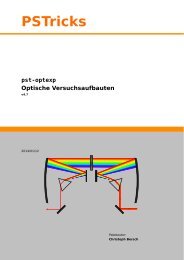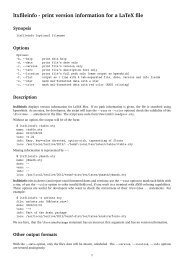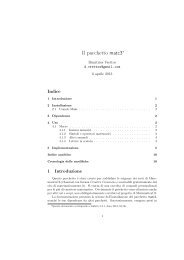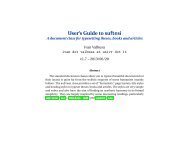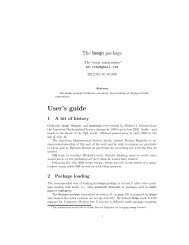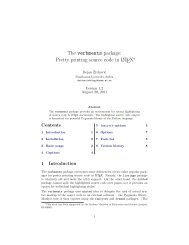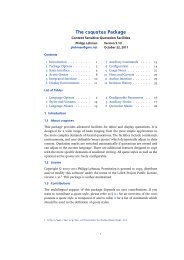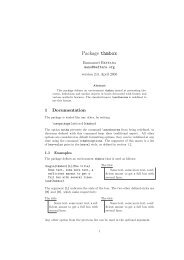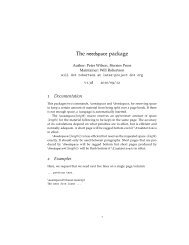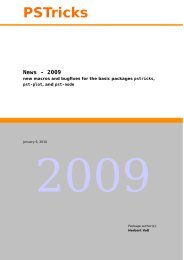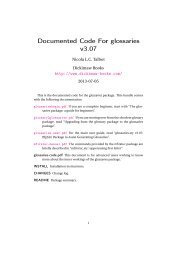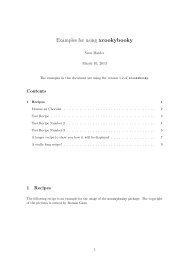Create successful ePaper yourself
Turn your PDF publications into a flip-book with our unique Google optimized e-Paper software.
4.2 Tag<br />
The tag option causes L ATEX to use just one aux file. This option, which is the<br />
default, works well. I am aware of the following two differences from the kernel’s<br />
including system:<br />
1. If the LATEX process is stopped during the processing of a part, all information<br />
normally stored in an aux file from that point in the document forward<br />
is lost. In the kernel’s system, processing the document twice more would<br />
recover any aux information previously generated for parts.<br />
If LATEX is always invoked in \nonstopmode (e.g., by AUC-TEX), then this<br />
difference is only going to occur when there are catastrophic errors that<br />
cause even \nonstopmode to terminate processing.<br />
2. Other packages and classes that redefine kernel commands that write to<br />
\@auxout will cause problems.<br />
The first difference must be accepted. The second difference can be removed<br />
on a case by case basis, by specifically coding compatibility with such packages<br />
and classes. I intend to do this. Here is a list of such packages and classes known<br />
to me:<br />
〈none so far〉 If you discover any more for this list, please write me!<br />
It’s also very easy to revise the other package to be compatible with <strong>newclude</strong><br />
as it is now. See section 6 below, which includes a list of relevant kernel commands.<br />
4.3 Allocate<br />
The second way (the allocate option) represents my first attempt at a solution,<br />
and until I am sure it has no advantages over tag under any circumstances, it will<br />
continue to be an option.<br />
The allocate option causes L ATEX to dynamically allocate TEX output streams<br />
to each part as they are needed. Streams are allocated when processing of the part<br />
begins, and are reclaimed after the ejection of the last page to which the part has<br />
contributed. Like the old system, a separate aux file is created for each part. The<br />
limitation of this implementation is that TEX only possesses 16 output streams.<br />
Each of the commands \tableofcontents, \listoffigures, \listoftables,<br />
\makeglossary, and\makeindex causes L ATEX to use one output stream. The<br />
remainder (minus any streams required by packages and classes) are available for<br />
the including system. If n streams are available, the level of nesting possible is<br />
n − 1 minus the maximum number of parts that occur on the same page. For<br />
example, if 10 streams are available and the parts never appear on the same page<br />
(the old behavior required by the \clearpages), then 8 levels of nesting are possible<br />
(which is 8, not 7 more than with the old system). The maximum number of<br />
parts that may contribute the to same page is calculated with the same equation.<br />
Note: TEX’s page-breaking algorithm looks ahead until it has more than enough<br />
material to fill one page. You must count all the new aux files that are opened<br />
during a look-ahead as contributing to the page in question, even if some of the<br />
later ones do not actually contribute to the page after the break is chosen.<br />
The allocate solution is itself implemented in two ways. The system either<br />
reserves a fixed number of output streams from the start, or will dynamically claim<br />
and free them as needed. The dynamic solution is the default. I do not see much<br />
8



